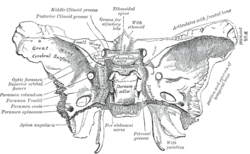棘孔
| 棘孔 | |
|---|---|
 蝶骨内面观,棘孔标示为左下方往上数第二个 | |
 颅底内面观,蝶骨标为黄色,棘孔可见于右下方 | |
| 标识字符 | |
| 拉丁文 | Foramen spinosum |
| TA98 | A02.1.05.038 |
| TA2 | 624 |
| FMA | FMA:53156 |
| 格雷氏 | p.150 |
| 《骨骼解剖学术语》 [在维基数据上编辑] | |
棘孔(Foramen spinosum)是人类颅底的一对孔洞,位于蝶骨棘的前方、卵圆孔的侧边,两侧各一。通过棘孔的构造有中脑膜动脉、中脑膜静脉和下颔神经脑膜支。
棘孔常在神经外科手术中作为定位点,可借由相对位置协助辨识其他颅底孔洞。18世纪时,贾柯柏·贝尼格纳斯·温斯洛首先描述了棘孔。
结构[编辑]
棘孔位于中颅窝内,是一个贯穿蝶骨的孔洞,[1][2]:771,和卵圆孔并列为蝶骨大翼上唯二的两对孔洞,卵圆孔则位于棘孔的前内侧[2]:776。棘孔的后内侧为蝶骨棘,外侧为下颔窝[2]:873,后方为耳咽管[1]。
变异[编辑]
棘孔的大小和位置因人而异。没有棘孔的人非常罕见,且通常只有单侧缺失,在此情形下,中脑膜动脉由卵圆孔进入颅腔[3]。棘孔也可能边缘不完整,估计半数的人有此现象;相反地,只有很少数的人(小于1%)有两对棘孔,这种些人也常有两对中脑膜动脉[1][3]。棘孔通常从蝶骨棘尖端或内侧表面(靠体轴中心处)穿过蝶骨[1]。
发育[编辑]
新生儿的棘孔长约2.25公釐,宽1.05公釐;成人棘孔则长约2.56公釐,宽2.1公釐[4],平均半径2.63公釐[5]。在一份研究棘孔、圆孔和卵圆孔发育的研究中,棘孔最早在出生后八个月、最迟在七岁前形成完整的环状构造,多数人最终会发育成圆形[5]。蝶颚韧带由咽弓发育而来,通常附著在蝶骨棘上,因此可能在棘孔边缘发现这条韧带[1][6]。
其它动物[编辑]
其他人科动物棘孔的位置不在蝶骨,而是在颞骨上,例如颞骨鳞状部或颞骨和蝶骨交界的蝶鳞缝,但也可能没有棘孔[1][7]。
功能[编辑]
棘孔使中脑膜动脉、中脑膜静脉和下颌神经脑膜支能通过颅骨,进入颅腔[1][2]:763。
临床重要性[编辑]
棘孔常因为其特殊的位置而在神经外科手术中作为定位点,用来判断其他颅底孔洞(包括圆孔和卵圆孔)、下颌神经和三叉神经节的位置。颅内创伤手术的止血也可能涉及棘孔。[1]
历史[编辑]
18世纪时,丹麦解剖学家贾克柏·温斯洛首次描述了棘孔,由于这个孔洞和蝶骨大翼的棘突位置相近,因此被命名为棘孔。然而,棘孔的拉丁文“foramen spinosum”在命名时使用了错误的词形变化,因此字面上的意思变成了“有很多棘的孔洞”;正确的词形变化应为“foramen spinae”,但反而比较少用[1]。
参见[编辑]
| 维基共享资源中相关的多媒体资源:棘孔 |
本条目使用了部分解剖术语。
参考资料[编辑]
本条目包含来自属于公共领域版本的《格雷氏解剖学》之内容,而其中有些资讯可能已经过时。
- ^ 1.0 1.1 1.2 1.3 1.4 1.5 1.6 1.7 1.8 Krayenbühl, Niklaus; Isolan, Gustavo Rassier; Al-Mefty, Ossama. The foramen spinosum: a landmark in middle fossa surgery. Neurosurgical Review. 2 August 2008, 31 (4): 397–402. doi:10.1007/s10143-008-0152-6.
- ^ 2.0 2.1 2.2 2.3 Drake, Richard L.; Vogl, Wayne; Tibbitts, Adam W.M. Mitchell; illustrations by Richard; Richardson, Paul. Gray's anatomy for students. Philadelphia: Elsevier/Churchill Livingstone. 2005. ISBN 978-0-8089-2306-0.
- ^ 3.0 3.1 Illustrated Encyclopedia of Human Anatomic Variation: Opus V: Skeletal Systems: Cranium – Sphenoid Bone. Illustrated Encyclopedia of Human Anatomic Variation. [2006-04-10]. (原始内容存档于2006-05-19).
- ^ Lang J, Maier R, Schafhauser O. Postnatal enlargement of the foramina rotundum, ovale et spinosum and their topographical changes. Anatomischer Anzeiger. 1984, 156 (5): 351–87. PMID 6486466.
- ^ 5.0 5.1 Yanagi S. Developmental studies on the foramen rotundum, foramen ovale and foramen spinosum of the human sphenoid bone. The Hokkaido Journal of Medical Science. 1987, 62 (3): 485–96. PMID 3610040.
- ^ Ort, Bruce Ian Bogart, Victoria. Elsevier's integrated anatomy and embryology. Philadelphia, Pa.: Elsevier Saunders. 2007: Elsevier’s Integrated Anatomy and Embryology. ISBN 978-1-4160-3165-9.
- ^ Braga, J.; Crubézy, E.; Elyaqtine, M. The posterior border of the sphenoid greater wing and its phylogenetic usefulness in human evolution. American Journal of Physical Anthropology. 1998, 107 (4): 387–399. PMID 9859876. doi:10.1002/(SICI)1096-8644(199812)107:4<387::AID-AJPA2>3.0.CO;2-Y.
外部链接[编辑]
- 人体解剖学在线(Human Anatomy Online)网站上的相关图片:22:os-0902 – "Osteology of the Skull: Internal Surface of Skull"
- Anatomy figure: 27:02-03 at Human Anatomy Online, SUNY Downstate Medical Center – "Schematic view of key landmarks of the infratemporal fossa."
- Anatomy of the Skull – 27. Foramen spinosum (页面存档备份,存于互联网档案馆)
|
